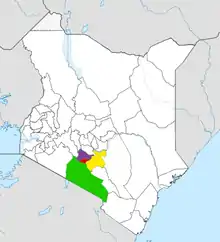Nairobi City County
Nairobi City County is one of the 47 counties of Kenya. With a population of 4,397,073 in the 2019 census, it is the third smallest yet the most populous of the counties, also serving as the capital of Kenya. In 2013, the county entity was effected, replacing Nairobi City Council, the long-standing unit of administration since pre-independence. The city county consists of eleven gazetted sub-counties and eighty five electoral wards. On the national level, Nairobi also sends seventeen Members of Parliament across the constituencies and one County Woman Representative to the National Assembly; one senator to the Senate. The county government, which is allocated devolved functions as per the constitution, is headed by the county governor, who appoints his cabinet. The county's legislature is headed by the County Speaker, who presides over the County Assembly: single-member elected Members of the County Assembly (MCAs) represent their respective electoral wards. Additional MCAs are also nominated by political parties as a form of affirmative action.
Nairobi City County | |
|---|---|
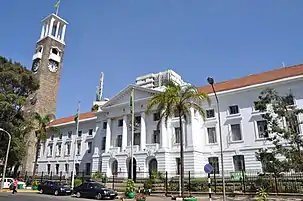 Nairobi City Hall | |
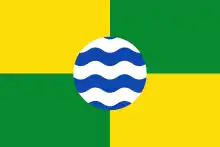 Flag 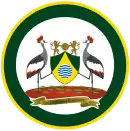 Coat of arms | |
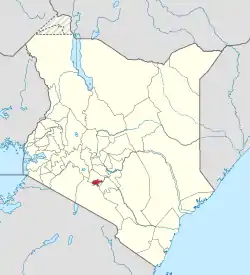 Location in Kenya | |
| Country | |
| Formed | 4 March 2013 |
| Capital | Nairobi |
| Sub-counties | |
| Government | |
| • Governor | Sakaja Johnson |
| • Senator | Edwin Sifuna |
| • County Woman Representative | Esther Passaris |
| Area | |
| • Total | 696.1 km2 (268.8 sq mi) |
| • Rank | 45th |
| Elevation | 1,795 m (5,889 ft) |
| Population (2019)[1] | |
| • Total | 4,397,073 |
| • Rank | 1st |
| • Density | 6,300/km2 (16,000/sq mi) |
| Time zone | UTC+03:00 (EAT) |
| HDI (2019) | 0.681[2] - medium |
| Poverty Rate | 1.3 %[3] - $1.90/day |
| Website | nairobi |
Nairobi City County shares the same boundaries as the then Nairobi Province; Kenya's eight provinces were sub-divided into forty seven Counties of Kenya as per the Constitution of Kenya, based on the forty seven districts that were established prior to 1992.
On 25 August 2022 after the general elections in Kenya, Johnson Sakaja was sworn-in as the fourth Governor of Nairobi County.[4]
Demographics
Based on the population census conducted by Kenya National Bureau of Statistics in 2019, determined the resident population of Nairobi City County was 4,397,073 within the city proper, the highest of the counties.[5] A breakdown of the population showed that there were 2,192,452 males, 2,204,376 females and 245 intersex individuals.[5] Embakasi Sub-county had the highest population of 988,808, accounting for more than 22% of the total population of the county; Kasarani came in second with 780,656. Kibra Sub-county with an area of 12.1 km2 (4.7 sq mi), had the least population among the sub-counties but had a high population density of 15,311/km2.[6][5] The population density was highest in the sub-county of Mathare with 68,942/km2 followed by a distant second by Kamukunji with 25,455/km2, then Makadara with 16150/km2, Kibra and Dagoretti with 15,311/km2, and 14,908/km2 respectively. [5] Lang'ata had the lowest population density with 911/km2, with the highest household size of 3.1.[5]
As a whole, Nairobi City had the highest number of households in the country with 1,506,888, with an average household size of 2.9, as well as the highest population density of 6247/km2 against the county's total area of 703.9 km2 (271.8 sq mi).[5]
Religion
Religion in Nairobi County [7]
| Religion (2019 Census) | Number |
|---|---|
| Catholicism | 1,041,619 |
| Protestant | 1,358,985 |
| Evangelical Churches | 897,741 |
| African Instituted Churches | 307,019 |
| Orthodox | 23,160 |
| Other Cristian | 225,003 |
| Islam | 326,809 |
| Hindu | 38,141 |
| Traditionalists | 7,029 |
| Other | 46,401 |
| No Religion/Atheists | 54,841 |
| Don't know | 9,047 |
| Not stated | 1, 285 |
Administrative and electoral boundaries
Nairobi is divided into 11 sub-counties, 17 electoral constituencies, and 85 wards.[8]
Leadership
| Term of office | Governor's Name | Political Party |
|---|---|---|
| 2013-2017 | Evans Kidero | ODM |
| 2017-2020 | Mike Sonko | Jubilee |
| 2021-2022 | Anne Kananu | N/A |
| 2022-2027 | Johnson Arthur Sakaja | UDA |
See also
References
- "2019 Kenya Population and Housing Census Volume I: Population by County and Sub-County". knbs.or.ke. Archived from the original on 13 November 2019. Retrieved 7 November 2019.
- Global Data Lab. "Human Development Indices: Sub-national HDI". globaldatalab.org. Retrieved 4 November 2022.
- "Sub-national HDI – Area Database – World Poverty Clock". WorldPoverty.io. Retrieved 4 November 2022.
- "Sakaja sworn in as the 4th Governor of Nairobi City County. | Nairobi City County". 25 August 2022. Retrieved 27 August 2022.
- "2019 Kenya Population and Housing Census Volume I: Population by County and Sub-County". KNBS. pp. 20, 29, 38. Retrieved 8 November 2022.
- "Embakasi and Kasarani most populated areas in Nairobi". The Standard. Retrieved 8 November 2022.
- "2019 Kenya Population and Housing Census Volume IV: Distribution of Population by Socio-Economic Characteristics" (PDF). Kenya National Bureau of Statistics. Retrieved 2 May 2021.
- Archived 19 March 2013 at the Wayback Machine
- "2019 Population By County and Sub-county". Archived from the original on 13 November 2019. Retrieved 30 May 2021.
Notes
- Kasarani Sub-county mainly uses the boundaries of the Kasarani Division prior to 2013. Ruai, Njiru and Kamulu are in Njiru Sub-county
- Mihang'o and Utawala are in Njiru Sub-county
